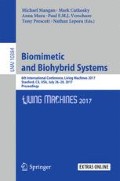Abstract
Due to the large number of evaluations required, evolutionary robotics experiments are generally conducted in simulated environments. One way to increase the generality of a robot’s behavior is to evolve it in multiple environments. These environment spaces can be defined by the number of free parameters (f) and the number of variations each free parameter can take (n). Each environment space then has \(n^f\) individual environments. For a robot to be fit in the environment space it must perform well in each of the \(n^f\) environments. Thus the number of environments grows exponentially as n and f are increased. To mitigate the problem of having to evolve a robot in each environment in the space we introduce the concept of ecological modularity. Ecological modularity is here defined as the robot’s modularity with respect to free parameters in its environment space. We show that if a robot is modular along m of the free parameters in its environment space, it only needs to be evolved in \(n^{f-m+1}\) environments to be fit in all of the \(n^f\) environments. This work thus presents a heretofore unknown relationship between the modularity of an agent and its ability to generalize evolved behaviors in new environments.
Access this chapter
Tax calculation will be finalised at checkout
Purchases are for personal use only
References
Bongard, J., Bernatskiy, A., Livingston, K., Livingston, N., Long, J., Smith, M.: Evolving robot morphology facilitates the evolution of neural modularity and evolvability. In: Proceedings of the 2015 Genetic and Evolutionary Computation Conference, p. 129136. ACM, Madrid (2015)
Bongard, J.: Morphological change in machines accelerates the evolution of robust behavior. Proc. Nat. Acad. Sci. 108(4), 1234–1239 (2011)
Bongard, J.C.: Spontaneous evolution of structural modularity in robot neural network controllers. In: Proceedings of the 2011 Genetic and Evolutionary Computation Conference, pp. 251–258. ACM, Dublin (2011)
Cappelle, C.K., Bernatskiy, A., Livingston, K., Livingston, N., Bongard, J.: Morphological modularity can enable the evolution of robot behavior to scale linearly with the number of environmental features. Front. Rob. AI 3, 59 (2016)
Clune, J., Mouret, J.B., Lipson, H.: The evolutionary origins of modularity. Proc. R. Soc. B Biol. Sci. 280(1755), 20122863 (2013)
Ellefsen, K.O., Mouret, J.B., Clune, J.: Neural modularity helps organisms evolve to learn new skills without forgetting old skills. PLoS Comput. Biol. 11(4), e1004128 (2015)
Espinosa-Soto, C., Wagner, A.: Specialization can drive the evolution of modularity. PLoS Comput. Biol. 6(3), e1000719 (2010)
French, R.M.: Catastrophic forgetting in connectionist networks. Trends Cogn. Sci. 3(4), 128–135 (1999)
Gruau, F.: Automatic definition of modular neural networks. Adapt. Behav. 3, 151–183 (1994)
Jakobi, N., Husbands, P., Harvey, I.: Noise and the reality gap: the use of simulation in evolutionary robotics. In: Morán, F., Moreno, A., Merelo, J.J., Chacón, P. (eds.) ECAL 1995. LNCS, vol. 929, pp. 704–720. Springer, Heidelberg (1995). doi:10.1007/3-540-59496-5_337
Kashtan, N., Alon, U.: Spontaneous evolution of modularity and network motifs. PNAS 102(39), 13773 (2005)
Lehman, J., Risi, S., D’Ambrosio, D., Stanley, K.O.: Encouraging reactivity to create robust machines. Adapt. Behav. 21, 484–500 (2013)
Lipson, H., Pollack, J.B., Suh, N.P., Wainwright, P.: On the origin of modular variation. Evolution 56(8), 1549–1556 (2002)
Matarić, M., Cliff, D.: Challenges in evolving controllers for physical robots. Rob. Auton. Syst. 19(1), 67–83 (1996)
Newman, M.E., Girvan, M.: Finding and evaluating community structure in networks. Phys. Rev. E 69(2), 026113 (2004)
Schmidt, M., Lipson, H.: Age-fitness pareto optimization. In: Riolo, R., McConaghy, T., Vladislavleva, E. (eds.) Genetic Programming Theory and Practice VIII. Genetic and Evolutionary Computation, vol. 8, pp. 129–146. Springer, New York (2011). doi:10.1007/978-1-4419-7747-2_8
Wagner, G., Pavlicev, M., Cheverud, J.: The road to modularity. Nat. Rev. Genetics 8(12), 921–931 (2007)
Yamashita, Y., Tani, J.: Emergence of functional hierarchy in a multiple timescale neural network model: a humanoid robot experiment. PLoS Comput. Biol. 4(11), e1000220 (2008)
Acknowledgments
We like to acknowledge financial support from NSF awards PECASE-0953837 and INSPIRE-1344227 as well as the Army Research Office contract W911NF-16-1-0304. We also acknowledge computation provided by the Vermont Advanced Computing Core.
Author information
Authors and Affiliations
Corresponding author
Editor information
Editors and Affiliations
Rights and permissions
Copyright information
© 2017 Springer International Publishing AG
About this paper
Cite this paper
Cappelle, C., Bernatskiy, A., Bongard, J. (2017). Reducing Training Environments in Evolutionary Robotics Through Ecological Modularity. In: Mangan, M., Cutkosky, M., Mura, A., Verschure, P., Prescott, T., Lepora, N. (eds) Biomimetic and Biohybrid Systems. Living Machines 2017. Lecture Notes in Computer Science(), vol 10384. Springer, Cham. https://doi.org/10.1007/978-3-319-63537-8_9
Download citation
DOI: https://doi.org/10.1007/978-3-319-63537-8_9
Published:
Publisher Name: Springer, Cham
Print ISBN: 978-3-319-63536-1
Online ISBN: 978-3-319-63537-8
eBook Packages: Computer ScienceComputer Science (R0)

